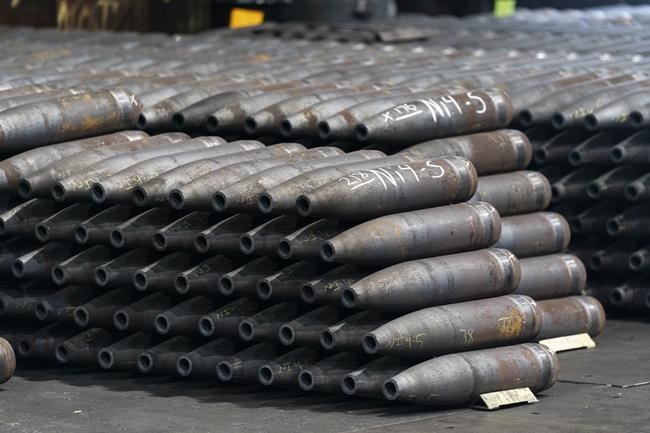WASHINGTON (AP) ŌĆö The Pentagon could get weapons moving to Ukraine within days once Congress passes . That's because it has a network of storage sites in the U.S. and Europe that already hold the ammunition and air defense components that Kyiv desperately needs.
Moving fast is critical, CIA Director Bill Burns said this past week, warning that without additional aid from the U.S., Ukraine could lose to Russia by the end of this year.
ŌĆ£We would like very much to be able to rush the security assistance in the volumes we think they need to be able to be successful,ŌĆØ Pentagon press secretary Maj. Gen. Pat Ryder said.
The House approved for the war-torn country Saturday after , R-La., pushed a larger foreign aid bill toward a vote despite threats from within his party that doing so . It still needs to clear the Senate.
After the House vote, Ukraine's president, Volodymyr Zelenskyy, said he was grateful ŌĆ£for the decision that keeps history on the right track.ŌĆØ He said on X, formerly Twitter that the House action ŌĆ£will keep the war from expanding, save thousands and thousands of lives, and help both of our nations to become stronger.ŌĆØ
President Joe Biden has said he would sign it ŌĆ£immediately.ŌĆØ
If that happens, ŌĆ£we have a very robust logistics network that enables us to move material very quickly,ŌĆØ Ryder told reporters this past week. ŌĆ£We can move within days.ŌĆØ
The Pentagon has had supplies ready to go for months but hasnŌĆÖt moved them because it is out of money. It has already spent all of the funding Congress had previously provided to support Ukraine, sending more than $44 billion worth of weapons, maintenance, training and spare parts since .
By December, , because it is going to cost more now to replace the systems it sent to the battlefield in Ukraine.
As a result, the PentagonŌĆÖs frequent aid packages for Ukraine dried up because thereŌĆÖs been no guarantee Congress would pass the additional funding needed to replenish the weapons the U.S. has been sending to Ukraine. The legislation would include more than $20 billion to restock the Pentagon's shelves and ensure that the military services have what they need to fight and protect America.
The lag in weapons deliveries has forced Ukrainian troops to spend months rationing their dwindling supply of munitions.
A look at how the U.S. can quickly move weapons to Ukraine:
PRESIDENTIAL DRAWDOWN AUTHORITY
When an aid package for Ukraine is announced, the weapons are either provided through presidential drawdown authority, which allows the military to immediately pull from its stockpiles, or through security assistance, which funds longer-term contracts with the defense industry to obtain the systems.
The presidential drawdown authority, or PDA, as itŌĆÖs known, has allowed the military to send billions of dollars worth of ammunition, , tanks, vehicles and other equipment to Ukraine.
ŌĆ£In the past, weŌĆÖve seen weapons transferred via presidential drawdown authority arrive within a matter of days,ŌĆØ said Brad Bowman, director at the Foundation for the Defense of Democracies center on military and political power.
Those stocks are pulled from bases or storage facilities in the U.S. or from European sites where the U.S. has already surged weapons to cut down on the amount of time it will take to deliver them once the funding is approved.
DWINDLING U.S. STOCKS
As the war in Ukraine has dragged on, the U.S. began to send increasingly larger, more lethal and more expensive systems to the warfront. They included entire air defense systems, armored vehicles, sophisticated missiles ŌĆö even .
, so the military ŌĆö in particular, the Army ŌĆö went deeper into debt. Compounding that, the military in some cases opted to replace older systems sent to Ukraine with pricier, higher-tech ones at home.
As a result, Army leaders recently told Congress that without passage of the foreign aid bill, they will begin to run out of money and have to move funds from other accounts.
Army Secretary Christine Wormuth and Gen. Randy George, chief of staff of the Army, said the branch wouldnŌĆÖt have enough money to bring home troops serving in Europe or to train units in the U.S.
U.S. WEAPONS STORAGE
The military has massive weapons storage facilities in the U.S. for of all sizes that would be ready to use in case of war.
For example, the McAlester Army Ammunition Plant in Oklahoma sprawls across 45,000 acres (70 square miles) connected by rail and has a mission to surge as many as 435 shipping containers ŌĆö each able to carry 15 tons (30,000 pounds) worth of munitions ŌĆö if ordered by the president.
The facility is also a major storage site for one of the most used munitions on UkraineŌĆÖs battlefield, 155 mm howitzer rounds.
has put pressure on U.S. stockpiles and pushed the military to see where else it could get them. As a result, tens of thousands of 155 mm rounds have been shipped back from South Korea to McAlester to be retrofitted for Ukraine.
STORING WEAPONS IN EUROPE
According to a U.S. military official, the U.S. would be able to send certain munitions ŌĆ£almost immediatelyŌĆØ to Ukraine because storehouses exist in Europe.
Among the weapons that could go very quickly are the 155 mm rounds and other artillery, along with some air defense munitions. The official spoke on the condition of anonymity to discuss preparations not yet made public.
A host of sites across Germany, Poland and other European allies also are helping Ukraine maintain and train on systems sent to the front. For example, Germany set up a maintenance hub for KyivŌĆÖs in Poland, near the Ukrainian border.
The nearby maintenance hubs hasten the turnaround time to get needed repairs done on the Western systems.
___
Follow the AP's coverage of Russia's war in Ukraine at .
Tara Copp And Lolita C. Baldor, The Associated Press



